Linux-based wireless handheld platform debuts
Feb 5, 2008 — by Eric Brown — from the LinuxDevices Archive — 3 views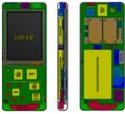 Finland-based Navicron has introduced Linux-based hardware and software reference designs for smart wireless devices. Navicron's FusionSoftware stack and Freescale-MX31-based FusionPlatform reference hardware are said to be designed for smartphones, Internet tablets, automotive computers,… and machine-to-machine (M2M) equipment.
Finland-based Navicron has introduced Linux-based hardware and software reference designs for smart wireless devices. Navicron's FusionSoftware stack and Freescale-MX31-based FusionPlatform reference hardware are said to be designed for smartphones, Internet tablets, automotive computers,… and machine-to-machine (M2M) equipment.
(Click for larger view of fusionplatform reference design)
The FusionPlatform hardware supports both Linux and Windows Mobile. However, Navicron chairman Matti Kattilakoski said, in an interview, “Our focus is on Linux, [but] if someone wants to use Windows Mobile, that is possible.”
Kattilakoski added, “We are primarily a Linux software development house, but we realized we needed to understand the hardware, so we created a hardware design. What differentiates us is that we provide a modular, flexible, design for faster time to market. If you wanted to replace GSM with CDMA, we can do that for you.”
That flexibility also applies to software, says Kattilakoski. “If you want to design a phone that uses Android, that's fine, we can support that. We are not trying to fragment the mobile Linux market even more.”
Hardware design
The FusionPlatform is built around Freescale's media-friendly i.MX31 SoC, which has an ARM11 core running at 532MHz. The multimedia application processor is backed up by a dedicated power management and audio circuit. It offers 128MB to 8GB of onboard NAND flash and 512MB to 1GB of mobile DDR SDRAM, says Navicron. For storage, it provides an SD slot for up to 8GB external flash, and supports IDE hard drives. The standard display is a 3.5-inch 640×480 TFT resistive, backlit touchscreen, and there are outputs for composite video and stereo headsets.
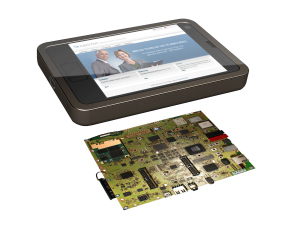

Different views of the Navicron FusionPlatform reference design
The reference platform includes connections for Fast Ethernet, 802.11b/g WiFi, serial and USB 2.0 and USB 1.1 connections. The design also supports GSM/GPRS cellular communications, Bluetooth, GPS, 3D accelerometers, CMOS camera, and FM radio. There's also a DVB video receiver and TV encoding. All these features are built-in, but can be easily subtracted for OEMs, depending on the desired end product, says the company.
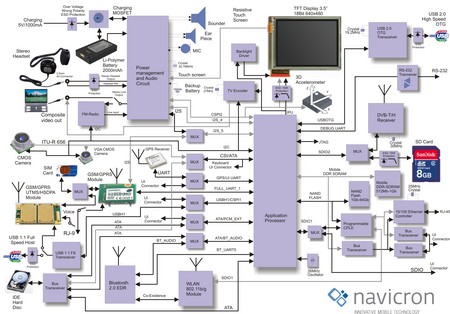
Navicron FusionPlatform function diagram
(Click to enlarge)
Software reference design
Navicron's FusionSoftware is designed for FusionPlatform, but can be adapted to fit other hardware platforms, says the company. Based on a Linux 2.6 kernel with GTK-based graphics, FusionSoftware supports customization via Python scripts. It offers a graphical user interface (GUI) designed primarily for touchscreens, and supports input from keyboard, finger, or stylus. Other features include language and translation support, and remote access via its Remote Access Integrated Server (RAIS). Software applications include a personal information manager (PIM), telephony, messaging, media player, and picture software.
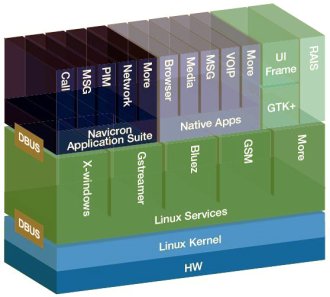
FusionSoftware architecture
(Click to enlarge)
The four-year old company has offices in Dallas, in addition to Oulu, Finland, and is said to have completed major projects for telecom companies. Navicron has also applied its expertise in the medical and sports technology sectors.
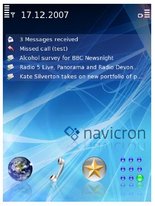
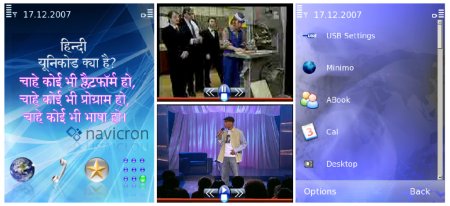
Fusionsoftware application screens
(Click to enlarge)
Availability
Navicron says that the FusionSoftware and FusionPlatform are available now, with complete Linux software development kits. The company plans to demonstrate its wares at the GSMA Mobile World Congress 2008 in Barcelona on February 11-14.
This article was originally published on LinuxDevices.com and has been donated to the open source community by QuinStreet Inc. Please visit LinuxToday.com for up-to-date news and articles about Linux and open source.